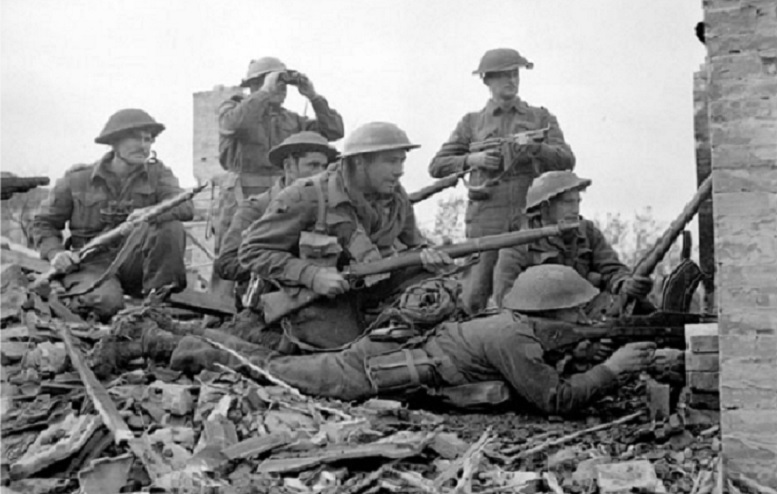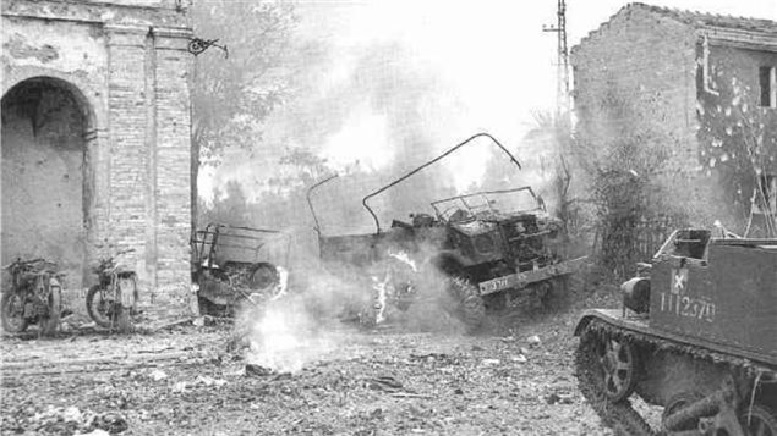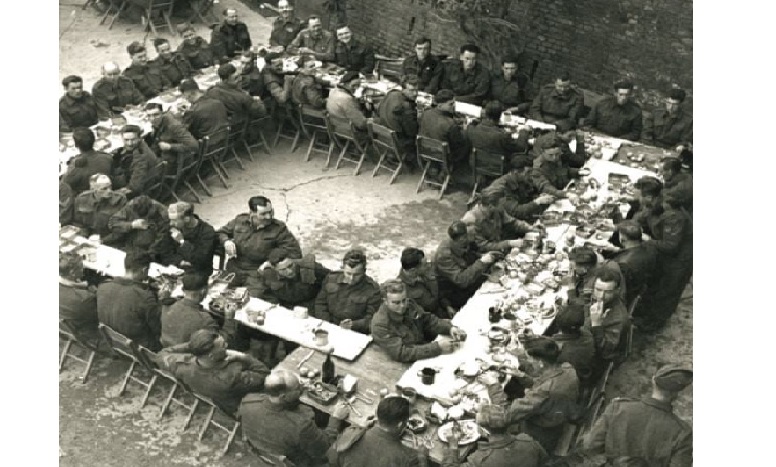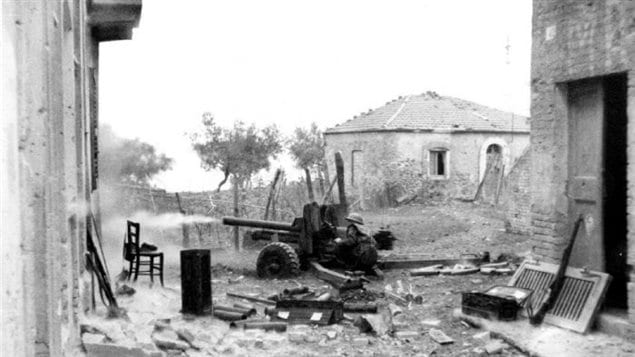It was not supposed to be a major battle. In the end, it was one of the bloodiest battles in the Italian campaign.
In December of 1943, a small town, Ortona, became the scene of a bitter siege as both Canadians and Germans fought for the ancient seaport.

Lt. I. Macdonald (binoculars) and Canadians of the 48th Highlanders- at San Leonardo di Ortona, 10 December getting ready to advance through a breached wall during the deadly fighting leading into Ortona. A variety of weapons from the Bren LMG, to a Thompson submachine gun to the standard bolt action Lee Enfield. Tragically the man holding the Thompson would be killed a few days later fighting in Ortona itself © Library and Archives Canada PA-163411
It became known as Canada’s “little Stalingrad”, a reference to the desperate and bitter battle in that Russian city.
It was on December 21, 1943, the Canadians began their attack on the town.
The Germans had been putting up fierce resistance in retreat as the allies pushed slowly up the boot of Italy when in December the Canadians were ordered to cross the Moro River and move on to the town of Ortona. After heavy and bitter fighting up through the Moro valley, it was thought that the Germans would not put up a stiff defence in the town as it wasn’t of considerable strategic importance and the Germans would have a better defensive position across another river further outside the town.
For some reason Hitler ordered the town be held at all costs, and a battle hardened elite parachute division was sent in.
The Germans had ordered civilians out of the town and established all their firing sight lines and laid mines and booby traps throughout the town. The also collapsed some buildings to block streets preventing tanks from entering, directing them to other defended areas where they’d be victims of either sticky bombs dropped from upper floors, or anti-tank weapons.
What transpired was bitter house to house combat; a deadly struggle for each blasted building, and each pile of rubble across each narrow winding street.

Dec. 23, 1943- A Canadian 15cwt CMP truck and a jeep burn after a hit by German mortars. The Germans had carefully established firing lines making the battle extremely fierce and deadly. Another Canadian designed vehicle- Universal carrier (aka bren carrier) is in the foreground © Public Archives Canada PA 170291
As it became impossible to safely fight in the streets, the Canadians developed a strategy called “mouse-holing”.
As one building was fought for, and cleared, the Canadians would blast a hole through the walls in the next building and fight to clear that one.
CBC newsman Matthew Halton in one report said, “It wasn’t hell. It was the courtyard of hell. It was a maelstrom of noise and hot, splitting steel…the rattling of machine guns never stops … wounded men refuse to leave, and the men don’t want to be relieved after seven days and seven nights… the battlefield is still an appalling thing to see, in its mud, ruin, dead, and its blight and desolation.

In one of Ortona’s more famous photos, the Seaforth Highlanders enjoy their Christmas dinner, in the bombed-out church at Santa Maria di Constantinopoli, Ortona, Italy, 25 December 1943. The dinner was made from foods scrounged, and troops were rotated away from the fighting just a couple of streets away, before being sent back to the fighting and then sent back to make room for others to enjoy a brief respite. For some, it would be their last meal. The battle resulted in a heavy death and casualty toll for the Canadians, the Germans, and for any townspeople who hadn’t left © Terry F. Rowe / Canada. Department of National Defence -Library and Archives Canada PA-152839
The vicious fighting went on day and night for a week, the Germans giving up ground inch by inch and only after heavy casualties on both sides.
Finally on 28 December, the remaining Germans pulled out, and Ortona was taken by the Canadians. The cost was high with over 1,300 Canadians killed in “bloody December”. About one-quarter of all Canadian casualties of the Italian campaign occurred in this one month alone.
It is unfortunate that this most fierce of battles displaying amazing courage and stamina by the Canadian attackers, and it must be said, also by the Germans, is largely forgotten.
additional info-sources
- Canadiansoldiers- Moro-Ortona
- Sean Chase story Daily Observer
- Canada at War- details Ortona
- Matthew Halton reports
- Parachute engineers- German perspective
One of several Youtube videos on the Ortona battle







For reasons beyond our control, and for an undetermined period of time, our comment section is now closed. However, our social networks remain open to your contributions.